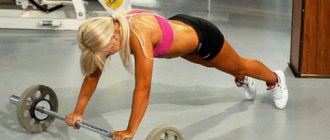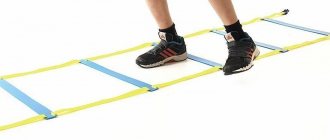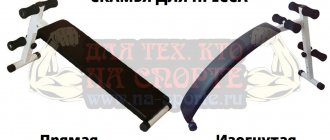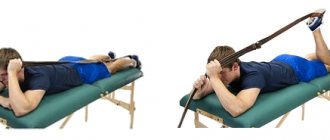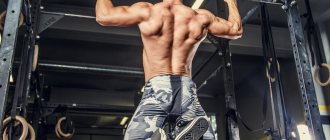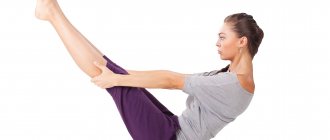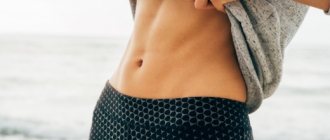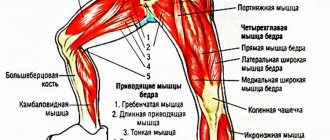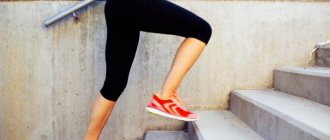AFTER SLEEP GYMNASTICS COMPLEX No. 1
1. " Stretch, return to and. P. 2. Leaning on the hands and heels of straightened legs, lift the pelvis up, hold, return to the standing position. 3. Bend over (raise the upper and lower parts of the body), hold, return to IP. 4 . Sit to the right of the heels, hands to the left, etc., sit to the left of the heels, hands to the right, etc. |
Near the cribs
5 .
"Ball
". I.p.: o.s.
Jumping on two legs.
- Breathing exercise
6.
“Let's listen to our breathing .”
I.p.: o.s., the muscles of the torso are relaxed.
In complete silence, children listen to their own breathing and determine which part of the body moves when inhaling and exhaling (stomach, chest, shoulders in waves), quiet breathing or noisy breathing.
AFTER SLEEP GYMNASTICS COMPLEX No. 2"WALK IN THE FOREST"
I. In cribs
1.
"
Stretch."
IP: lying on your back, arms along the body, stretching.
2.
“
A forest dweller sleeps in a hanging cradle in summer” (walnut).
IP: lying on your back, arms along your body.
Inhale, sit with straight legs, hands to toes, exhale, inhale, etc.
II.Near the cribs
3.
“
Here the Christmas tree bent over, green needles.”
IP: standing, feet shoulder-width apart, hands below.
Inhale, exhale, bend the torso forward, inhale, etc., exhale, bend.
4.
“
Here is a tall pine tree standing and moving its branches.”
I.p.: o.s.. Inhale, arms to the sides, exhale, tilt the torso to the right, inhale, exhale, tilt the torso to the left.
5.
“Children in berets fell from a branch, they lost their berets” (acorns
).
I.p.: o.s.. hands behind your head, inhale - rise on your toes, exhale - squat.
6.
“Alena is standing, green foliage, thin figure, white sundress” (birch
). I.p.: standing, feet shoulder-width apart, arms along the body, inhale, arms through the sides up, rise on toes, exhale, etc.
III . Breathing exercise
7.
"The forest is noisy."
I.p. – feet shoulder-width apart, arms down. Bend to the right - inhale, return to I.p. – exhale, the same to the left. Complication - the arms are extended upward when performing. AFTER SLEEP GYMNASTICS COMPLEX No. 3
I. In beds Who sleeps sweetly in bed?
It's high time to get up.
Hurry up to charge,
We won't wait for you!
Breathe deeply through your nose,
Keep your backs straight.
- IP: lying on your back, arms along your body, tense your body, inhale, hold for a few seconds, relax, exhale.
- IP: lying on your back, arms to the sides, fingers clenched into fists, cross your arms in front of you, exhale, spread your arms, in IP, inhale.
- IP: lying on your back, hands behind your head, raise your left leg straight, raise your right leg straight, keep them together, etc. (lower at the same time).
- IP: lying on your back, hands resting on your elbows, bend over, lift your chest up, keep your head straight (3-5 sec), return to IP.
- IP: lying on your stomach, hands under your chin, bend over, hands to your shoulders, legs lying on the bed, hold, IP.
- IP: lying on your stomach, hands under your chin, bend over, placing emphasis on your forearms, neck stretched - inhale and exhale.
The benefits of morning exercises
It's already difficult to get up in the early morning, and waking up an hour earlier to go for a run or to the gym seems like an impossible task. Motivation may be enough for a month, but what next? It is necessary to constantly maintain a toned body and maintain normal weight. The “diet – uncontrolled gluttony” swing will have a bad effect on the skin, and stretch marks will appear, commonly called stretch marks.
Especially for those who like to linger in bed after the alarm clock rings, an effective system of exercises has been invented that allows you to do them without getting up and without going to the gym.
Gymnastics for lazy people, lying in bed, keeping the body in good shape, helping to lose weight is not a dream, but a reality.
Tangible benefits:
- toned body;
- feminine forms;
- improved blood circulation;
- a boost of energy for every day;
- increasing endurance;
- strengthening the performance of the lungs;
- stabilization of the nervous system;
- quick awakening;
- good mood;
- improvement of well-being;
- strengthening immunity;
- stabilization of hormonal levels;
- high concentration of attention;
- increased productivity;
- improvement of metabolism;
- the first step in the fight against dangerous laziness.
The set of exercises is extensive, choose the most productive and interesting for yourself, combine, alternate daily. Implement a complex aimed at strengthening the entire body and specifically the abs. Perform daily for at least 5-7 minutes, and 2-3 times a week stretch for 20-25 minutes. Woke up, yawned, stretched and - get to work!
II. Near the cribs
7.
"Clapperboard".
IP, - kneeling, arms along the body. Inhale - spread your arms to the sides, exhale - lower them down, clap your hands, say: “Clap!” Repeat six to eight times.
III . Breathing exercise
"Let's listen to our breathing».
I.p.: o.s., the muscles of the torso are relaxed.
In complete silence, children listen to their own breathing and determine which part of the body moves when inhaling and exhaling (stomach, chest, shoulders in waves), quiet breathing or noisy breathing.
AFTER SLEEP GYMNASTICS COMPLEX No. 4
"AIRPLANE"
In cribs
- I.p.: sitting, “Turkish style.” Look up without raising your head, and move your finger behind the flying plane (following with your eyes).
An airplane flies by
I got ready to fly with him.
- I.p. Same. Move your right hand to the side (follow with your gaze), and the same to the left.
The right wing was withdrawn,
I looked.
Left wing withdrawn
I looked.
- I.p. Same. Perform rotational movements in front of the chest and follow with your eyes.
I'm starting the engine
And I look carefully
.
Exercises to Maintain Bone Health
Physical activity is important at any age, especially for women over 50, when bone loss accelerates. This set of exercises improves strength, coordination, flexibility and balance. These exercises can be done at home or in the gym, which is convenient for busy women. Exercise and nutrition are important parts of bone health, but they may not be enough to treat postmenopausal osteoporosis. Be sure to talk to your doctor about maintaining bone health and before starting any new exercise routine.
Warm up.
Before you begin any exercise or physical activity, it is important to do a simple warm-up.
Warm-up will take about 4-5 minutes.
1. Stand up straight and start marching in place. Breathe calmly. Help yourself with your hands, let them move in time with your movements, forward and backward. Continue marching in place for about 1 minute.
2. Then lower your arms down and place your palms on your waist. Slow down the pace of walking and raise your legs bent at the knees one at a time to a right angle between the thigh and torso. Continue this movement for another minute.
3. Move your arms away from your body and take steps from side to side, simultaneously bending and straightening your elbows. Continue these movements for another minute to warm up your body.
4. Stop and place your feet slightly wider than shoulder-width apart. Stretch your arm in front of your chest in the opposite direction. Now stretch with your other hand. Repeat the exercise 5 times.
5. Lower your arms down and slowly lift your shoulders up, then lower them. Repeat this movement 5 times.
6. At the end, place your feet together, straighten up and draw in your stomach. Step back with one foot and place your heel on the floor. This is an exercise to stretch the muscles of the back of the leg. Take a deep breath while keeping the muscle stretched. Now step back with your other leg and repeat the stretching exercise.
Before you start exercising, be sure to consult your doctor. If you experience any discomfort during exercise, you should stop immediately and consult a doctor.
Exercise to Maintain Bone Health
Bone Health Training is designed to promote healthy bone tissue. Completing the entire set of exercises will take about 20 minutes. If you can't do all the exercises at once, do some now and some later. It makes sense to exercise throughout the day.
If pain occurs, stop exercising.
Squats with crossed arms
This exercise strengthens the abdominal and lower torso muscles.
Take a sturdy chair, sit on the seat and cross your arms over your chest. Tighten your legs a little, suck in your stomach, then stand up. Distribute your weight evenly on both feet. With your arms crossed, sit in a chair, keeping your weight in your heels and pulling your belly button in. It is recommended to perform two sets of 8-12 repetitions.
This exercise stretches the chest muscles and strengthens the upper back muscles.
Sit on a sturdy chair with your feet flat on the floor. The back is straight, the neck is an extension of the spine. Look straight ahead, bend your elbows. Pull your elbows back and squeeze your shoulder blades together, continuing to move your arms back as far as possible, but so as not to cause any discomfort. Hold this position for 5-10 seconds, breathing as usual. Return to the starting position. It is recommended to perform two sets of 10 repetitions.
Leg extension in a sitting position.
This exercise strengthens the thigh muscles.
Sit on a chair with your feet flat on the floor, straighten your back and place your hands on your hips. Place a towel under one thigh for better support. Looking straight ahead, tighten your abdominal muscles. Slowly straighten the leg with the towel underneath without bending your back. Hold the position for a few seconds, breathing as usual. Relax and return to the starting position, then perform the exercise on the other leg. It is recommended to perform two sets of 10 repetitions for each leg.
Calf Raise/Knee Curl.
This exercise strengthens the calf muscles and hamstrings.
Stand behind a chair and grab the back of it for balance. Rise up onto your toes, placing your weight on your big toes. Slowly lower yourself until your heels touch the floor. Next, bend one knee, lifting your heel toward your hamstrings or buttocks. Tighten the back of your leg, then slowly straighten your leg. Repeat the exercise on the other leg, then stand on your heels and repeat the sequence (calf raises/knee bends). It is recommended to perform two sets of 6-12 repetitions for each exercise.
Push ups.
For those who find it difficult to do regular push-ups, it is recommended to do wall push-ups.
This exercise strengthens the upper torso.
Lower yourself to the floor, resting on your palms and knees. Slowly lower your torso towards the floor, elbows pointing out to the sides. Without touching the floor, return your torso to the starting position. An easier version of this exercise is to hold this position with your elbows slightly bent, but not leaning over. It is recommended to perform two sets of 8-12 repetitions.
Squatting and stretching.
This exercise improves posture and strengthens the chest muscles.
Starting position: standing, feet hip-width apart. Raise your arms to shoulder level, elbows bent, fingers pointing up. Squeeze your shoulder blades together, moving your arms back and down. Hold this position and slowly squat down into a V-shape position. Hold this position, then return to the starting position. It is recommended to perform two sets of 8 repetitions.
Stretch from a sitting position.
This exercise stretches your shoulder muscles and strengthens your back and abdominal muscles.
Sit on a sturdy chair with your feet flat on the floor. Extend both arms up. Stretch your arms as high as possible. Then, while continuing to extend one arm up, reach down with the other arm. Repeat the exercise changing hands. It is recommended to perform a total of five cycles.
Walking “heel to toe” while maintaining balance (tightrope walker’s step), various options.
This exercise strengthens the muscles in your legs and torso and improves your balance.
Extend your arms out to the sides and walk heel-to-toe for six steps in a row. Repeat on the other side. Now, at every third step, raise your leg bent at the knee to a right angle with your body, stay in this position, then lower your foot down. Repeat for the other knee. Repeat the exercise by taking six more steps and adding a touch to the raised knee with the palm of the opposite hand. Now repeat in the other direction. It is recommended to perform three sets for each exercise option.
Heel sliding.
This exercise strengthens your abdominal muscles.
Lie on your back, straighten your legs. Contract your abdominal muscles and press your lower back into the floor. Using a sliding motion, move your right heel towards your torso until it causes discomfort. Hold this position, then straighten your leg with a sliding movement. Now repeat for the other leg. It is recommended to perform two sets of 10 repetitions for each leg.
Pelvic tilt
This exercise strengthens the muscles of the lower back and abdomen.
Lie on your back, bend your knees, and press your feet to the floor. Maintain the natural curve of your back, do not arch. Tighten your abdominal muscles by pulling your navel in toward your spine. Tilt your pelvis slightly upward without lifting your hips, maintain the natural curve of your back, do not arch, or use the muscles of your legs and buttocks. Hold this position for 5 seconds, continuing to breathe calmly, then relax. It is recommended to perform two sets of 10 repetitions.
Upper back lift
This exercise strengthens your back muscles.
Lie face down on the floor with a pillow under your stomach and thighs. Place a small rolled towel under your forehead. Place your arms on the sides of your body, tighten your abdominal muscles. Raise your head and chest 5–10 cm from the towel. The head should be in line with the neck and torso, looking down. Don't raise your shoulders towards your ears. Two sets of 5 repetitions are recommended.
Hitch.
The cool-down includes stretching on the floor and breathing exercises. This will help slow your breathing and stretch your muscles so you don't feel stiff the next day. The cool down takes about 4-5 minutes.
1. Lie on your side, then roll over onto your back. Slowly bring one knee toward your chest and, holding this position, stretch the muscles. This exercise allows you to stretch the muscles of the back of the leg, thigh and buttocks. Hold your leg gently, avoiding any springing or pulling movements. Lower and straighten your leg, then repeat the stretch on the other leg. Perform the exercise several times on each side.
2. Now bring your knees back to the center and straighten your torso while lying on your back. Extend your leg upward until slight tension appears in the back of your thigh. Move to the other leg.
3. Bring your bent right knee towards your chest and press on it, moving it in the opposite direction, turning your torso to the left side. Now you are lying on your side. Pull both knees toward your chest and, pushing off the floor with your right hand, lift your torso and sit on your hands and knees.
4. There should be a chair next to you, you need to lean your palm on it. Bring one foot forward and push off the seat to lift your torso off the floor. Sit on a chair, then take a deep breath and exhale. Place one palm on top of the other on your knees, lift them with a deep breath, then lower them. Do this exercise a few more times.
Material from the site: https://www.osteoporozu.net/
Near the cribs
- I.p.: o.s. Stand on your toes and perform flying movements.
I rise up, I fly.
I don't want to go back.
- I.p.: o.s., close your eyes tightly for 5 seconds, open (repeat 8-10 times).
- I.p.: o.s., blink your eyes quickly for 1-2 minutes.
- Breathing exercise
- "Adjuster
" I.p. standing, feet shoulder-width apart, one arm raised up, the other to the side. Inhale. Change the position of the hands with an extended exhalation and pronouncing the sound “R-R-R” (4-5 times).
AFTER SLEEP GYMNASTICS COMPLEX No. 5
"Snowman"
In cribs
One and two, one and two
Simulate making snowballs
We are making a snowman.
We'll roll a snowball
Alternately pass along the neck on the right and left
Somersault, somersault.
Run fingers over cheeks from top to bottom
We blinded him cleverly,
Rub the wings of the nose with your index fingers
Instead of a nose there is a carrot.
Instead of eyes - coals,
Place your palms to your forehead and “visor” and rub
Handles and twigs were found.
They rub their palms together.
And on the head - a bucket.
Rub the index and middle fingers
points in front of and behind the ears
Look, here it is!
Place both palms on the top of your head and shake your head.
Common mistakes
Below are the most common mistakes that most people make.
- Lifting the body off the floor following the legs. This exercise involves only raising your legs - your back lies on the floor.
- No mat, doing the exercise on a cold floor. Neglecting this seemingly trifle is harmful to your health. First, purchase a polymer soft mat. Secondly, ensure there is no draft.
- Performing the exercise in jerks. If you repeat the movements very quickly, you get a chaotic contraction of the muscles of the whole body. Inertia arises, and a lot of necessary forces are spent on extinguishing it. Obey speed limits.
- No delay when raised. This is acceptable if your abs are still weak. To increase efficiency, it is recommended to linger at the top point for 1–2 seconds.
- Throwing your legs to the floor after lifting. Each movement must be performed smoothly and under muscle control. When using weights, you can get a sprain (in the case of abs, it’s rare, but it happens).
- Listen to your body. If it hurts, stop doing the exercise. Try again another time. If it hurts another time, reduce the load. Usually the back hurts when you start lifting both legs at once.
- The angle of your leg flexion should be determined by your strength and stretching abilities. Aim for straight legs.
- If you have eaten, wait at least an hour. Exercising on a full stomach is harmful and difficult.
As with any workout, when working on the abs, you should follow the principle of gradualness. If your body has not previously experienced physical activity, start with the simplest option. That is, start with lifting one leg, and if this is easy for you, move on to raising both legs.
To comprehensively work out the abs, it is recommended to combine leg raises with exercises that primarily work the upper segment of the rectus muscle.
II.Near the cribs
Sitting on chairs
- «we'll warm you up forfrozen feet after walking in the snow
": stretch your legs forward, clench and unclench your toes; stretch your legs forward, pull your legs with your toes and heels; stretch your legs forward and join them,
- «paint
» with your feet in the air various geometric shapes (circle, square, triangle); place your entire foot on the floor, raise your legs on your toes, lifting your heels off the floor as much as possible; from the same IP raise your toes up without lifting your feet from the floor.
Repeat each exercise six to eight times.
- Breathing exercise
"Snowflakes".
I. p.: o. p., arms bent at the elbows, palms up (“snowflakes fell on the palm”). Inhale through your nose and blow into your palms, say “fu-fu-fu” (lips with a tube) (“snowflakes flew”).
AFTER SLEEP GYMNASTICS COMPLEX No. 6
In cribs
- I.p.: lying on your back, arms along the body, raise straight legs up, i.p.
- "Log."
IP: lying on your back, arms up, roll from back to stomach, roll from stomach to back.
- "Boat".
IP: lying on your stomach, hands under your chin, bend over, hands to your shoulders - inhale, IP. -exhalation.
- "Barrier".
I.p.: lying on the stomach, arms along the body, raise the right leg, i.p., raise the left leg, i.p.
- «Ladybug".
IP: sitting on your heels, straighten up, stretch up, sit on your heels, bend forward, touch your knees with your nose, move your arms back, etc.
Purpose of the exercise
Performing leg raises while lying on the floor is an easier version of hanging leg raises. The exercise can be easily done at home. This does not require any additional devices. Therefore, it is a universal remedy for maintaining abdominal muscle tone in any circumstances.
What are lying leg raises used for:
- To strengthen the abdominal muscles, especially the lower part, at any level of physical fitness.
- To increase abdominal strength and endurance.
- Exercise has a therapeutic effect on the body. In particular, it is used as an element in the prevention of osteochondrosis and intervertebral hernias, and is also suitable for rehabilitation after abdominal surgery on the peritoneum.
- As an element of morning exercises for children and adults.
II.Near the cribs
- Self-massage of the head
(“let’s wash our hair”).
I.p. —
sitting on chairs. The teacher gives instructions, the children imitate the movements: “Turn on the water in the shower. Touch it... Oh, it's hot! Add cold water, wet your hair, pour shampoo into your palm, lather your hair, wash your hair thoroughly from all sides... No, the back is not washed at all. Good now! Rinse off the foam again from all sides. Sasha still had foam on his temples. Now everything is clean, turn off the water. Take a towel and gently dry your hair. Take a comb and comb your hair thoroughly. Don't press the comb too hard or you will scratch your scalp. You are so Beautiful!"
III . Breathing exercise
7.
“Pump”
Stand straight, feet together, arms down. Inhale, then tilt the torso along the body to the side - exhale. Hands slide along the body to the side, while saying “s-s-s-s.” Repeat 6-8 bends in each direction.
AFTER SLEEP GYMNASTICS COMPLEX No. 7
In cribs
- I.p.: Lying on your back, arms along your body, raise your arms up, pull yourself up, arms forward, etc.
- I.p.: lying on your back, arms along the body, pull your socks towards you, i.p.
- I.p.: Sitting, legs straight, arms supported at the back, spread the toes to the sides, etc.
- «A pedestrian
" I.p. the same, stepping with your toes, bending your knees, the same with straightening your legs.
Near the cribs
- «Hammers
" I.p.: sitting, legs bent, arms supported behind the back, toes on the toes, hitting the floor with the left heel.
I.p.: o.s., Hands on the belt, rolling from toes to heels.
III .
Breathing exercises .
"Little Frog."
I.p. - main stand. Imagine how the frog makes quick, sharp jumps. Squat down slightly, sigh, push off and jump with both legs moving forward. As you exhale, slowly say “K-v-a-a-a.”
AFTER SLEEP GYMNASTICS COMPLEX No. 8
I. In cribs
1.
IP: lying on your back, arms along the body, raise your right leg (straight), IP, raise your left leg (straight), IP.
2.
IP: lying on your back, hands in front of you “holding the steering wheel”, “riding a bicycle”, etc.
3.
I.p.: lying on your back, arms up, turn the body to the right, i.p., turn the body to the left, i.p.
4.
IP: lying on your back, hands behind your head, bring your elbows together in front (elbows touching each other) - exhale, IP, elbows touching the bed - inhale.
5.
I.p.: sitting, legs crossed, hands on the belt, arms up through the sides - inhale, exhale.
II.Near the cribs
When performing the exercises, inhale through the nose, mouth closed.
6.
“Start the engine.”
I.p.
-
stand with your feet apart, hands in front of your chest, clenched into fists. Inhale - i.p.; exhale - rotate your bent arms (one around the other) at chest level; At the same time, pronounce “R-r-r-r” with one breath. Repeat four to six times.
III . Breathing exercise
7.
Breathe in one nostril
Starting position - sitting, standing, the torso is straightened, but not tense.
1. Close the right nostril with the index finger of the right hand. Take a quiet, long breath through the left nostril (sequentially lower, middle, upper breathing).
2. As soon as the inhalation is completed, open the right nostril and close the left one with the index finger of the left hand - through the right nostril, exhale quietly for a long time, emptying the lungs as much as possible and pulling the diaphragm as high as possible so that a “pit” is formed in the stomach.
3-4. Same with the other nostrils. Repeat 3-6 times. AFTER SLEEP GYMNASTICS COMPLEX No. 9
. I. _ In cribs
1. The sun is shining in the window
Looking into our room
We'll clap our hands
We are very happy about the sun.
Children wake up, clap their hands
- Woke up my nose
Woke up my ears.
Woke up my mouth
Woke up my eyes
We rub, yawn, open, close our eyes (3-4 times)
How to develop abdominal strength, pump up your six-pack and increase endurance
It should be understood that it is impossible to pump up both at once. To achieve each goal, the tactics will be different.
Strength and volume
This exercise, in itself, when performed solo, is not very suitable for creating sculpted abs. To achieve pronounced results, it is necessary to combine it with other exercises for the abdominal muscles. It can be:
- lifting the body on a Roman chair;
- hanging leg raises;
- double twists;
- oblique twists, etc.
Note that when performing abdominal exercises, in particular, lying leg raises, volume and strength can be increased by following the following rules:
- Number of approaches 3–4.
- Reps in each approach are 10–12.
- We use maximum weights (those when you can do 10–12 repetitions with the correct technique, no more).
- Adding loads. Do you feel like you can do more without your technique suffering? Let's increase it. Gradually, there is no need to rush!
Endurance
Everything is much simpler here. We do the maximum possible number of repetitions in a prone position in an accelerated version. Two approaches are quite enough to expand the limits of abdominal endurance. We work through the burning sensation in the muscles.
II. Near the cribs
6.
“
My back is straight.”
I.p. —
narrow stance, hands behind the back, clasped.
My back is straight, I'm not afraid of bending over
(lean forward)
:
I straighten up, bend over, turn around
(actions in accordance with the text).
One, two, three, four, three, four, one,
two
(torso turns)!
I walk with a proud posture, laughing straight away
(walking in place).
One, two, three, four, three, four, one, two
(torso turns)!
I can sit down and stand up, sit down and
stand up again
(actions in accordance with the text),
I'll lean here and there! Oh, straight back
(torso bends)!
One, two, three, four, three, four, one,
two
(torso turns)!
III . Breathing exercise
7.
“Traffic Controller.”
I.p.
standing, feet shoulder-width apart, one arm raised up, the other to the side. Inhale. Change the position of the hands with an extended exhalation and pronouncing the sound “R-R-R” (4-5 times). AFTER SLEEP GYMNASTICS COMPLEX No. 13
“Flight to the Moon”
I. In cribs
1.
IP: lying on your back, arms along the body, raise your right leg (straight), IP, raise your left leg (straight), IP.
2.
I. p.: lying on your back “riding a bicycle.”
3.
I.p.: lying on your back, arms up, turn the body to the right, i.p., turn the body to the left, i.p.
4.
I.p.: sitting, legs crossed, hands on the belt, arms up through the sides - inhale, exhale.
II.Near the cribs
- «Start the engine
" I.p. – stand with your legs apart, hands in front of your chest, clenched into fists. Inhale - i.p. – rotate bent arms (one around the other) at chest level; At the same time, pronounce “R-r-r-” with one breath. Repeat 4-6 times.
- «We're flying on a rocket
" I.p. – on your knees, arms up, palms together above your head. Inhale – i.p.; long exhalation - sway from side to side, transferring the weight of the body from one leg to the other, pronounce drawn out: “oo-oo-oo-oo.” Repeat - 4-6 times.
- «We put on the helmet from the spacesuit
" I.p. – squatting, hands clasped above your head. Inhale – i.p.; exhale - spread your arms to the sides, say: “Chick.” Repeat – 4-6 times.
- «Getting into the lunar rover
" I.p. – narrow stance, arms along the body. Inhale - i.p.; exhale - full squat, arms forward, say: “Wow!” Repeat - 4-6 rubles.
- «Sleepwalkers
" I.p. – kneeling, arms bent at the elbows and spread to the sides, fingers apart. Inhale – i.p.; exhale - tilt your torso to the side, say: “Hee-hee.” Repeat three to four times in each direction.
III . Breathing exercise
- «Let's breathe fresh air on Earth
" I.p. – legs apart, arms along the body. Inhale – raise your arms up through the sides; exhale - lower your arms smoothly, say: “Ah!” Repeat - 4-6 times.
AFTER SLEEP GYMNASTICS COMPLEX No. 14
"SLEEPING THE SEA KINGDOM"
I. In cribs
- Octopus stretches its legs, (Complete relaxation)
- The octopus tucked its legs (Slight tension)
- The octopus has opened (Complete relaxation)
- And now we are fish
Let's play with fins
Hands on shoulders, slow circular movements of shoulders
- Let's check the scales
Circular movements of the shoulders
- Let's straighten the fins
Run your hands along your body
- The fish's tail is playing.
Slowly move your toes or alternately lift
- Let's straighten the upper fin,
Let's play with a fin
Roll over on your stomach, shaking your back
- And now we are stars
Lying on my back
- The stars opened up.
Complete relaxation, arms outstretched
- Let's swim like bugs - water meters.
Slide forward and backward on the bed on your stomach
- We stretched, shook ourselves,
So the sea kingdom woke up.
Spinal hernia: what sports exercises should be performed
A hernia is a common pathology in which the fibrous ring of the disc protrudes from its normal location, which can lead to its prolapse into the spinal canal. Aching pain in the lower back, lumbago, numbness - such symptoms can be signs of concern.
If measures are not taken, the disease will lead to irreparable consequences, such as compression of the spinal cord and disruption of the functioning of even internal organs. Currently, this pathology occurs in people of all ages (20 years and older) and can appear in any part of the spine. However, the most common symptom is lumbar intervertebral hernia.
and neck.
Is it possible to cure a hernia with sports?
Definitely yes. Sport is necessary for this disease, but it does not cure. The main task of the exercise sets is to strengthen and normalize the tone of the back and abdominal muscles. This is why you should first consult your doctor.
Proper physical therapy will reduce pressure in the problem area, activate blood circulation, eliminate congestion, improve metabolism, restore previous activity, and prevent pain.
However, it is necessary to understand that each person is individual, and the symptoms of the disease are very serious, so physical activity should not be done during the acute phase. If pain is present, the workout should be stopped immediately. You need to adjust to your own pace, working out smoothly and measuredly.
What exercises should you do to stay healthy?
Exercises you can do yourself at home:
- Lying on your back, bend your knees and extend your arms along your body. Draw in your stomach as you inhale, tensing your abdominal muscles. Hold the maximum retraction for 10 seconds. Relax your stomach while inhaling slowly. Recommended number of repetitions is 5-10 times.
- A similar exercise, but with the upper body elevated. Raise your head and chest 20-30 degrees, keeping your hands on the back of your head. Stay elevated for 5-10 seconds and slowly lower down. Repetitions – 5-10 times.
- Bend your knees while lying on your back. Slowly pull the lower limbs one by one towards the stomach. You can help yourself with your hands. It is necessary to fix the position of the knees near the stomach and slowly return to the starting position.
- Lying on your back, raise your legs one by one and straighten them at the knee joint. We hold this limb up for 7 seconds and slowly lower it. We repeat a similar exercise with the other leg. Repetition frequency – 8-10 times.
- Lying on your stomach, you need to press your hands to your thighs. Raise your head and chest as far as possible. You need to hold this position for 8 seconds. Then lower yourself to the floor and relax for 10 seconds. Number of repetitions 10 times.
- Lying on your stomach, stretch out your arms and legs. Raise your arm and opposite leg at the same time. Be sure to pull the toe of the foot back, but do not throw back the head. Hold this body position for 10 seconds. We repeat this with the second leg and arm. The recommended number of exercises is 5-10 times.
What sports are useful for this diagnosis?
Some sports will help normalize the condition of spinal problems:
- Pilates. This is a type of fitness that consists of static exercises without strength effort. It is a special discipline for restoring the body after injury. The peculiarity of Pilates is that it can be performed by people of any gender, age and physical fitness.
- Swimming. Water reduces the load on the spine, and movements in the pool engage most of the muscles of our body, developing the respiratory and musculoskeletal system.
- Sports or recreational walking. This is a safe way to control muscle mass and joint mobility. However, to be effective, you need to walk briskly for 30-40 minutes every day. If you have severe pain or heart disease, walking should be at a slow pace.
- Nordic walking. In case of spinal hernia, it is most effective, since the body weight is transferred to special devices - ski poles. Nordic walking is much more effective than regular walking, because almost all the muscles of the body are used during the training process. It is worth paying attention to the breathing process to prevent oxygen starvation.
- Yoga. Basic exercises can relieve muscle tension and relax the problem area.
What absolutely cannot be done with this spinal disease
If you have problems with the spine, you need to follow restrictions that help maintain health.
First of all, you need to avoid:
- Lifting heavy things.
- Bath procedures.
- Overheating of the hernia site.
- Sedentary lifestyle.
- Self-medication.
- Active winter sports.
There should be no frivolous attitude towards massage - be sure to consult a doctor before the procedure. Do not neglect special corsets prescribed by a specialist.
What exercises should you exclude from your workouts:
- Loads on the legs - this position of the body creates an additional impact on the spine, causing muscle hypertonicity and pain.
- Twisting bodies - like standing exercises, increases excessive muscle tone.
- Exercises with a gymnastic ball - they are based on twisting the body, and its implementation should be excluded.
- Lifting a barbell - any load with weight is dangerous due to the risk of further displacement of the vertebrae.
- Running - since the discs perform a shock-absorbing function, and when running the load on them will be increased.
- Vertical hanging - since the spine will experience a huge load, pathological stretching may occur.
Author: K.M.N., Academician of the Russian Academy of Medical Sciences M.A. Bobyr
II. Near the cribs
8 .
The fish are frolicking
. I.p.: o.s.
Jumping on two legs.
III .
Breathing exercise
9.
“Let’s listen to the breath of the sea .”
I.p.: o.s., the muscles of the torso are relaxed.
In complete silence, children listen to their own breathing and determine which part of the body moves when inhaling and exhaling (stomach, chest, shoulders in waves), quiet breathing or noisy breathing.
AFTER SLEEP GYMNASTICS COMPLEX No. 20
“RAISING ANNOUNCED”
I. _ In cribs
- The rise is announced!
The dream is over - let's get up!
But not at once.
Hands first
We woke up and stretched.
Children lie in bed on their backs, moving straight arms forward and up, arms bent to the sides.
- Legs straighten
We danced a little.
Movement of the feet left and right, forward and backward, stepping on the bed with bent legs.
- Let's roll over on our stomachs
Let's bend over.
Exercise "Ring"
- And then on your back again, now the bridges are ready.
Exercise "Bridge"
- Let's go a little
By bike. (
Simulation of cyclist movements)
- We raise our heads, (
Raise your head)
- We don’t want to lie sick
. (Get up)
